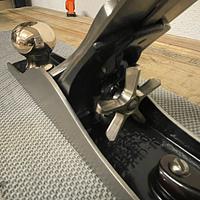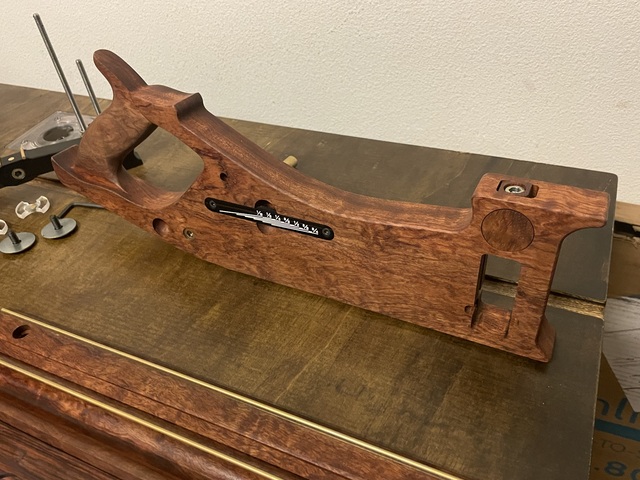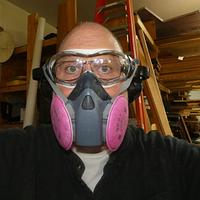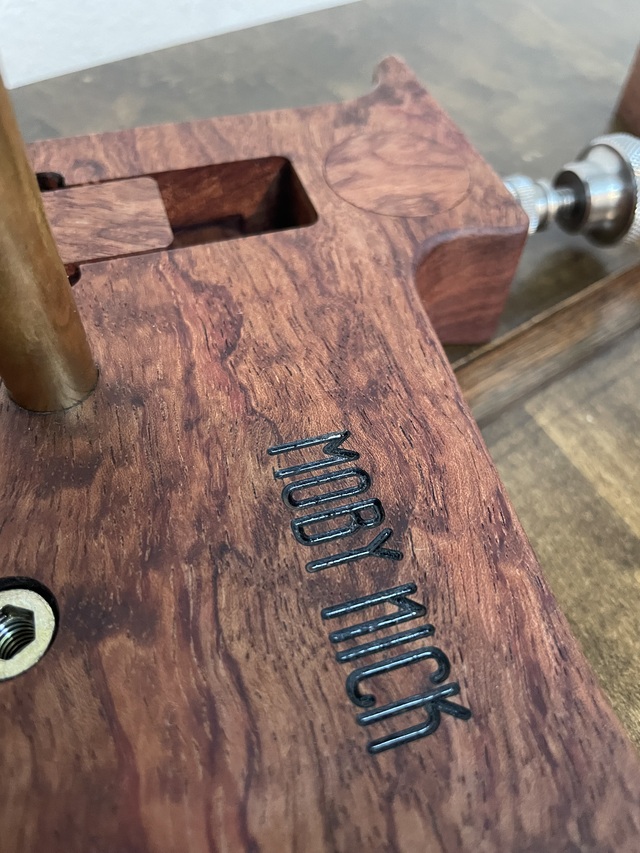Share your craft projects
Make new craft buddies
Ask craft questions
Blog your craft journey

DevinT
2746 posts
and
20 followers
in about 3 years
in about 3 years
3-Arm Kerfing Plane #7: Little details
This is
part 7
in a
8 part
series:
3-Arm Kerfing Plane
These are words I tell myself in the throes of the process:
Any fool can put something together. It takes a special kind of fool to design something to be taken apart.
That is exactly what I did. I designed it not only to fail gracefully (short of being thrown across the room, it should not fail easily) but be serviceable.
One of the components in the design is a CNC’d 60-degree chamfer on one side of a pocket that allows a 5/16” open-end wrench to slip behind the moveable fence to reach a swivel nut. This relief cut is demonstrated in my newly uploaded video, demonstrating how to disassemble the thing.
Now that I have the prototype disassembled, I can now document which round-overs I used on which parts.
I did not document that the first time through as I just went with what felt good. Meaning, when I made the prototype, after I completed all the CNC bits (with Shaper Origin), I take the parts over to the router table to gradually increase roundovers on edges in steps until the thing feels nice (or I chicken out on going further, whichever happens first).
ASIDE: I had, for example, planned on maybe taking some of the edges up to a bull-nose profile but then changed my mind while stepping up radii, simply because I like the feel and don’t want to ruin a good thing (and so often decide to stop short of initial round over plans). The scenario for this prototype was no different, and now I have to document after-the-fact which edges on which parts got what final radius. Then this new information will be both applied to the second piece (shown before any edge profiling is done) and amended to the Shaper Hub instructions I am building (which are now on version 197 and over 5,000 lines — but by-Golly! if you just step through each one it all works amazingly).
Obligatory shop-dog photo. He has to pee, so I need to take him out right after posting this. He is moaning, he must really have to go. Got to cut this short.
Any fool can put something together. It takes a special kind of fool to design something to be taken apart.
That is exactly what I did. I designed it not only to fail gracefully (short of being thrown across the room, it should not fail easily) but be serviceable.
One of the components in the design is a CNC’d 60-degree chamfer on one side of a pocket that allows a 5/16” open-end wrench to slip behind the moveable fence to reach a swivel nut. This relief cut is demonstrated in my newly uploaded video, demonstrating how to disassemble the thing.
Now that I have the prototype disassembled, I can now document which round-overs I used on which parts.
I did not document that the first time through as I just went with what felt good. Meaning, when I made the prototype, after I completed all the CNC bits (with Shaper Origin), I take the parts over to the router table to gradually increase roundovers on edges in steps until the thing feels nice (or I chicken out on going further, whichever happens first).
ASIDE: I had, for example, planned on maybe taking some of the edges up to a bull-nose profile but then changed my mind while stepping up radii, simply because I like the feel and don’t want to ruin a good thing (and so often decide to stop short of initial round over plans). The scenario for this prototype was no different, and now I have to document after-the-fact which edges on which parts got what final radius. Then this new information will be both applied to the second piece (shown before any edge profiling is done) and amended to the Shaper Hub instructions I am building (which are now on version 197 and over 5,000 lines — but by-Golly! if you just step through each one it all works amazingly).
Obligatory shop-dog photo. He has to pee, so I need to take him out right after posting this. He is moaning, he must really have to go. Got to cut this short.
7 Comments
Even though I am now familiar with the project, the beauty of these parts still impresses me!
😊 thank you.
Part of me wonders if the same would be true with a domestic wood like Walnut.
Part of me wonders if the same would be true with a domestic wood like Walnut.
That is a piece of art Devin....very well done, congrats and thanks for showing us.
Mike
I’m impressed.
Now I need to read 1-6.
Now I need to read 1-6.
Beautiful, and built like a Swiss watch, well at least it has that many parts. :-)
Looks like every one of them is dead centered, and accurate as can be. Nice Devin. I can't wait to see it in action.
How old is your pooch?
Looks like every one of them is dead centered, and accurate as can be. Nice Devin. I can't wait to see it in action.
How old is your pooch?
I want to say he is 11 or 12 years old now. He’s getting on in years and is certainly needing a little more love and does not want to handle stairs as much. He still gets occasional bursts of playfulness, but because of his age I don’t play rough with him anymore. He can for example tear a pad on the asphalt if I have him jumping to catch a ball on anything but grass (which is limited in this urban environment).
Thanks for the kind comments on the plane.
Funny thing, I just installed new shop lights and I had been on the fence about whether I liked them or not (they are very bright). However, after taking some more photos of the plane, I think the new lights are a good thing. Let me know …
Thanks for the kind comments on the plane.
Funny thing, I just installed new shop lights and I had been on the fence about whether I liked them or not (they are very bright). However, after taking some more photos of the plane, I think the new lights are a good thing. Let me know …
When I look at these photos taken under the new lights, I am blown away. They are so crisp with a level of contrast in color that I wasn’t getting before.
To my eye, these “Daylight Deluxe” bulbs have me often confused thinking that I left the main garage door up, because I see what my mind registers as Daylight spilling out of the garage, but it will be 10P and my brain does not register that it would be impossible given that it is dark outside.
Here is a picture taken in daytime. You can compare the sliver of daylight coming out from behind the black curtain against the light spilling out from my shop.

That’s how well these bulbs are simulating Daylight for me. It’s kind of eerie actually, and even after a week I had still been unsure of whether I liked it — but holy moly, just look at these photos compared to before!
I can certainly find things in my tiny shop more easily, that’s for sure!
I think more light is always a good thing. At least until you can never see a shadow. On the pics my eyes say decidedly clearer, and that wood went from very sexy, to OMG l@@kit that wood. Much better IMHO.




































